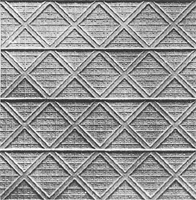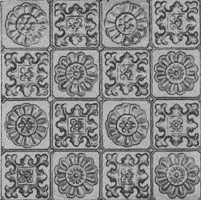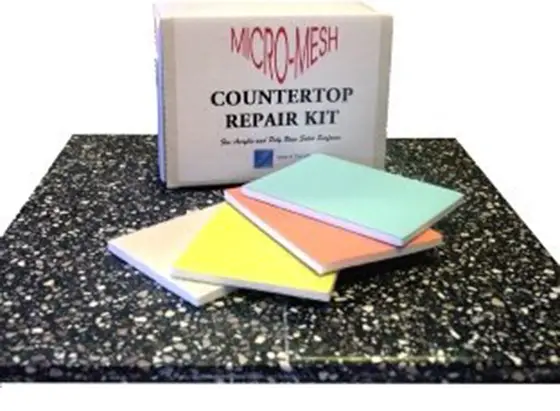A Strange Beginning
Plastic laminate was born in an entirely different industry. With the growth of the electronic industry in the early 1900's, engineers needed an insulating material to mount electrical components.This material needed to be rigid, non-conductive, easy to work, etc. Somehow, somebody soaked some paper in a melamine resin. After heating, the paper became hard. BINGO! Plastic laminate was born. The engineers used this material to make circuit boards and other insulators.
This process was invented by a company called Micarta. Evidently, someone in management had a bright idea one day. They thought, "Why not use a decorative paper as the top layer?" Yes, you guessed it! Plastic laminate for the home was on its way.
Well, the top brass at Micarta, so I'm told, didn't want to get into this market. They wanted to make electronic equipment. Several of the managers decided to leave and start their own company.
They were sitting around trying to come up with a name and not having much luck. The story goes that one of them said, "Well, we are now former employees of Micarta. What are we going to do?" It was that easy! Believe it or not, this is a true story.
Laminate, What is it?
In a nutshell, plastic laminate is simply multiple layers of thin paper which is soaked in a melamine resin. These impregnated layers of paper are subject to high pressure and temperature which hardens the paper and resin.
The colors, patterns, etc. that you see are just the top layer of decorative paper. Beneath the decorative paper layer lie sheets of brown kraft paper. These layers of kraft paper impart resilience or resistance to impact. The more layers of kraft paper, the better the laminate can withstand impact.
That Brown Line
Probably the biggest complaint concerning plastic laminate is the telltale brown line one often sees at the edge of the laminate. This brown line is simply the layers of kraft paper.
Manufacturers responded some time ago and produced laminate that was merely layer upon layer of decorative paper. This produced a solid color throughout the laminate. However, the cost of this laminate was extremely high. In fact, in some marketplaces, the cost was nearly the same as the solid surface countertops.
Selection Extravaganza
The competition in the plastic laminate market is fierce. This competition is healthy. Two by-products of this competition are low prices and incredible selection. One major manufacturer has over 200 different types of laminate to choose from.
Solid colors, imitation stone finishes, wood grains both natural and frosted, imitation marble, and numerous patterns make for a tough time when trying to select a laminate for a countertop or cabinet face.
Decorative Moldings
If you haven't visited a kitchen cabinet showroom lately, you're in for a surprise. Remember those rolled, rounded bullnose countertop edges? Those are history! Now there are new distinctive decorative edge moldings that incorporate different color and textured laminates or actual wood to finish the edges of countertops.
These new edge treatments take care of the brown edge problem. The laminate that is used in these edgings is actually mitred so that the kraft paper is hidden. The added benefit is the ability to mix and match different laminates within these edge treatments. You can create accent stripes within the countertop.
What's more, there are at least nine different edge treatment styles you can choose from. Some are rounded, while others are square or beveled. Some will accept accent strips of a different laminate or other material.
Solid wood moldings are also available which are specifically made for the countertops. Often the manufacturers will offer these in different species to compliment their entire line of laminates.
Good, but...
Plastic laminate is a great material but it is by no means indestructible. The plastic coating which acts as the top layer can be damaged. Hot pots and pans can scorch the material. Cigarettes will easily burn a plastic laminate top. Abrasive cleaners will scratch these materials.
Certain foods, liquids (grape juice, red wine, etc.) can and will stain plastic laminate. Although the clear top layer of laminate looks impervious, it is not in many cases.
Plastic laminate is hard, but not hard enough to use as a cutting surface. A sharp knife will easily scratch plastic laminate. Don't be tempted to use it as a cutting board.
Different Thicknesses
Plastic laminate is usually available in three different thicknesses: general purpose, vertical surface and post forming.
The general purpose laminate is what most of us are familiar with. This product is the thickest laminate measuring out at .050 inches! Yes, that is pretty thin. That's nothing, the vertical grade material is usually only half as thick as that.
The only difference between the two is the amount of brown kraft paper beneath the decorative paper. The general purpose material, because of this added paper, can absorb more shock. As such, it tends to resist chipping.
The vertical grade material is used on cabinet fronts, display cases or any other vertical surface that receives little contact with objects.
The post forming laminate is very flexible. It is used where laminate is applied to curved or rolled substrates.



